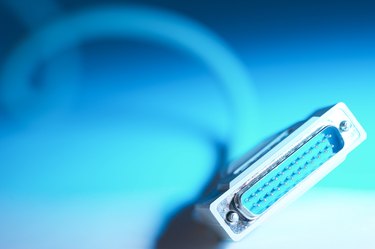
Most modern printers designed for personal use have only a USB port for connecting to a computer. However, many heavy-duty business printers include other port options for connecting to legacy servers, networks and workstations. Of the various printer interfaces produced over the years, parallel ports emerged as the most commonly used. Introduced in the early 1970s by Centronics, and then adapted for use with personal computers by IBM in the 1980s, parallel cables were the dominant type of connection medium for printers until the introduction of USB. Even with the widespread use of USB, many printers still are outfitted to use various types of parallel cables.
Connector Types
Video of the Day
Parallel printer ports on computers are virtually all the same with the exception of those on a very few custom-made machines. Consequently, the ends of the parallel cables that connect to PCs are the same regardless of type. All parallel cables have a male DB-25 connector that connects to the female DB-25 port on the rear of the computer. Connectors on the opposite end of a parallel cable, though, can vary depending on the type of external device to which the cable connects. Most printers made before the emergence of USB had 36-pin Centronics adapters. Modern heavy-duty business printers that still include parallel port connections usually have this type of interface as well. Therefore, the most common connector combination found on a parallel cable is a male DB-25 to Centronics 36-pin connection type. A few older HP and IBM laser printers shipped with a smaller Mini-Centronics connector. The standard 36-pin Centronics connector used to connect to printers has a large female slot opening with metal slots on either side. The Mini-Centronics interface used for cables needed for a few older laser printers resembles a much smaller version of the original Centronics connector.
Video of the Day
IEEE Standards
Just as with most other computer cables and devices, manufacturers produce parallel cables based on IEEE industry standards. The IEEE 1284 standards define the standards for the various types of printer cables and how they transmit data from computers to printers or other devices. There are two types of IEEE standards for parallel cables: IEEE 1284-I and IEEE 1284-II. IEEE 1284-I covers cables that use DB-25 to Centronics 36-pin cables. IEEE 1284-II covers all cables that have a Mini-Centronics connector. Therefore, unless you have an older HP or IBM printer that has a Mini-Centronics connector, look for a printer that supports the IEEE 1284-I standard. Both IEEE standards for parallel cables use virtually the same pin-out and wire assignments in the cabling. Additionally, both 1284-I and 1284-II support daisy chaining up to eight devices from a single DB-25 parallel port on a computer. To use the daisy chain feature with parallel ports, both the computer operating system and application from which you print must be able to identify different devices sharing a single port. Modern versions of Windows support port sharing with parallel ports. However, not many applications support the feature.
Parallel Port Modes
Parallel cables support several modes for initiating communication between the host computer and a printer or other device. Early parallel cables supported only the Centronics standard mode often referred to as SPP -- Standard Parallel Port -- mode or Compatibility mode. Parallel cables made since the early 1990s support IEEE 1284 standards also support EPP (Enhanced Parallel Port) and ECP (Extended Capabilities Port) modes. SPP supports transfer speeds up to about 480kb per second, while EPP and ECP support transfer speeds of 2 megabytes per second and about 5 megabytes per second respectively. SPP, EPP and ECP all support full-duplex mode (sending and receiving data at the same type) if the application initiating print jobs using commands associated with Nibble Mode. When initiating a print job with Nibble mode, the computer sends 4 bits of data to the connected printer and waits a few milliseconds for a response. If the computer receives the response from the printer within a predetermined wait period, it sends the data in full-duplex mode, resulting in faster printing and release of the port by the application. If the computer does not receive a fast response from the printer, it reverts to Compatibility mode and sends data in half-duplex mode, which requires more time to complete print jobs in most cases.
Adapter Cables
In addition to standard parallel cables types, several adapter cables exist for connecting computers with parallel ports to serial printers as well as PCs without parallel ports to older printers. A parallel-to-serial adapter cables allows business users to connect line or receipt printers to a computer's parallel port without requiring dip-switch or conversion boxes in most cases. For newer workstations without parallel ports, business owners can use USB-to-parallel adapter cables to connect and use older printers. To connect a USB printer to an older computer with only a parallel port, you must use an active conversion box, as no reliable parallel-port-to-USB printer cable currently exists.